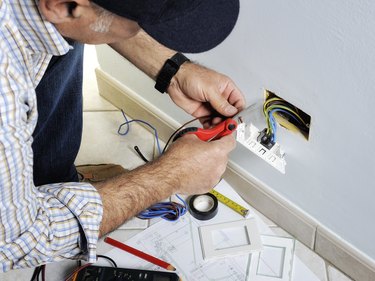When you are doing a remodel of your kitchen, you might find it necessary to relocate your stove. This is more complicated than merely removing the stove plug from the socket, sliding the appliance across the floor and reconnecting it to another outlet, however. Stoves require a special receptacle for safety reasons, so you will need to know how to move a 220-volt outlet in order to use your stove in its new location. Some basic safety procedures must be followed when undertaking this sort of work.

Video of the Day
Safety Basics for Electrical Work
Before you begin work in your kitchen, power off your appliances and shut the power off to the area at the breaker level. Let others know you'll be working with electricity and ask that they don't restore power until you are done. Use rubber-handled tools and high-voltage gloves to be as safe as possible. If you are confused about any part of the process, you should request help from an electrician or other professional.
Video of the Day
How to Move a Stove Outlet
Before you can begin work on the electricity in your kitchen, you'll need to move your stove out of the way. In addition, any appliances or cabinetry that block the stove's new position must be moved.
Next, remove the cover from your current stove's electrical receptacle. If there is enough slack on the wires, you might be able to pull them to the desired location. If not, however, you will have to relocate the outlet. To do this, you can transition the current electrical box to a junction box. Then, splice a wire from the j-box to the new electrical receptacle. If you have any questions about how to install a 220-volt outlet for a stove, you should check with an electrician before proceeding.
Wiring Differences
Depending on what outlet you are converting, you will need to know a bit about the wiring differences between 120-volt and 240-volt outlets. Generally speaking, most everyday household appliances, such as chargers and lamps, can rely on 120-volt outlets safely and effectively. However, other appliances, such as your washing machine, stove or dishwasher may require 240 volts to run safely. In fact, an oven that is connected to a 120-volt outlet will only produce a quarter of the heat that it would if it were properly connected to a 240-volt outlet. In general, a gas range may require only 120 volts, which will make your electric stove wiring project a bit easier. However, electric ranges should use 240 volts of power.
3-Slot vs. 4-Slot Receptacles
In addition to their voltage differences, standard outlets and higher-voltage ones differ in terms of their number of slots. A 120-volt outlet might have just three slots, a neutral and a hot slot, in addition to the arch-shaped grounding slot. However, outlets appropriate for appliances like stoves tend to have two hot slots, in addition to the grounding slot and the neutral wire slot. If you have an existing 3-slot outlet, it's okay to keep using it. However, modern construction is requiring 4-slot outlets for these types of appliances, so when you relocate your stove, you should convert the outlet to a 4-slot version for safety and compliance.